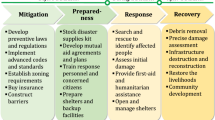Abstract
With the increasing frequency of hydrological hazard events during the last years, also the problem of combined rain and snow melt hazards has increased. A series of remarkable hazardous events in Switzerland, particularly the severe flood in August 2005, triggered a cooperation between the official Swiss warning centres for individual natural hazards. This cooperation became increasingly supported and was pushed politically. A main outcome was a joint project to launch the so-called Common Information Platform for Natural Hazards GIN (“Gemeinsame Informationsplattform Naturgefahren”). The objective was to achieve a system to allow a combined and user-friendly visualisation of safety relevant data in real time along with granting access to substantial information provided by the warning centres. A further goal was to strengthen the collaboration between the Swiss warning centres, particularly by the provision of joint bulletins in critical multi-causal events. In this way, GIN will become the central information hub for natural hazard events in Switzerland. A first user satisfaction evaluation of the web-based information platform revealed positive results. This paper focuses on the description of GIN and discusses the development work behind it.












Similar content being viewed by others
References
Apache Software Foundation (2010) XMLBeans. http://xmlbeans.apache.org/. Accessed 31 May 2010
Arpagaus M, Rotach MW, Ambrosetti P, Ament F, Appenzeller C et al (2009) MAP D-PHASE: Demonstrating forecast capabilities for flood events in the alpine region. In: Federal Office for Meteorology and Climatology MeteoSwiss (ed) Veröffentlichung MeteoSchweiz Nr. 78. Federal Office for Meteorology and Climatology MeteoSwiss, Zurich, pp 1–75
Aschwanden H (2000) Hochwasser 1999. Analyse der Messdaten und statistische Einordnung. In: Landeshydrologie und -geologie (ed) Bundesamt für Wasser und Geologie BWG, Bern, pp 1–116
Bärring L, Persson G (2006) Influence of climate change on natural hazards in Europe. Natural and technological hazards and risks affecting the spatial development of European regions. Geol Surv of Finl 42:93–107 special paper
Bründl M, Etter HJ, Steiniger M, Klinger C, Rhyner J et al (2004) IFKIS–a basis for managing avalanche risk in settlements and on roads in Switzerland. Nat Hazards Earth Syst Sci 4:257–262. doi:10.5194/nhess-4-257-2004
ESRI (2010) ArcGIS web mapping. http://www.esri.com/software/arcgis/web-mapping/index.html. Accessed 31 May 2010
Gruber S, Hoelzle M, Haeberli W (2004) Permafrost thaw and destabilization of alpine rock walls in the hot summer of 2003. Geophys Res Lett 31:L13504. doi:10.1029/2004GL020051
Haeberli W, Burn C (2002) Natural hazards in forests–glacier and permafrost effects as related to climate changes. In: Sidle RC (ed) Environmental change and geomorphic hazards in forests. CAB International, Wallingford, pp 167–202
Haines A, Kovats RS, Campbell-Lendrum D, Corvalan C (2006) Climate change and human health: impacts, vulnerability and public health. Public Health 120:585–596. doi:10.1016/S0140-6736(06)68901-0
iBATIS (2010) iBATIS for java. http://ibatis.apache.org/. Accessed 31 May 2010
IPCC (2007) Europe. In: Parry ML, Canziani OF, Palutikof JP, van der Linden PJ, Hanson CE (eds) Climate change 2007: impacts, adaption and vulnerability. Contribution of working group II to the fourth assessment report of the Intergovernmental Panel on Climate Change. Cambridge University Press, Cambridge, UK, pp 541–580
ISO (1999) Human-centred design process for interactive systems. ISO 13407: 1999. International Organisation for Standardisation, Geneva, pp 1–19
ISO (2008) ISO in brief: international standards for a sustainable world. International Organisation for Standardisation, Geneva
Lehner B, Doll P, Alcamo J, Henrichs T, Kaspar F (2006) Estimating the impact of global change on flood and drought risks in Europe: a continental, integrated analysis. Clim Change 75:273–299. doi:10.1007/s10584-006-6338-4
Marks J, Shieber S (1991) The computational complexity of cartographic label placement. Technical Report. Center for Research in Computing Technology, Harvard University, Cambridge, pp 1–27
Martin E, Giraud G, Lejeune Y, Boudart G (2001) Impact of a climate change on avalanche hazard. Ann of Glaciol 32:163–167. doi:10.3189/172756401781819292
McBean G (2004) Climate change and extreme weather: a basis for action. Nat Hazards 31:177–190. doi:10.1023/B:NHAZ.0000020259.58716.0d
Petzold I, Gröger G, Plümer L (2003) Fast screen map labelling–data-structures and algorithms. In: Proceedings of the international cartographic conference, Durban, 2003
Prototype Core Team (2010) Prototype JavaScript framework. http://prototypejs.org/. Accessed 31 May 2010
Romang H, Zappa M, Hilker N, Gerber M, Dufour F et al (2010) IFKIS-Hydro: an early warning and information system for floods and debris flows. Natural Hazards (in print). doi: 10.1007/s11069-010-9507-8
Schwierz C, Köllner-Heck P, Zenklusen Mutter E, Bresch D, Vidale P-L et al. (2010) Modelling European winter wind storm losses in current and future climate. Clim Change (in print) pp 1–30. doi: 10.1007/s10584-009-9712-1
SpringSource (2010) Spring framework. http://www.springsource.org/. Accessed 31 May 2010
The Dojo Foundation (2010) Dojo toolkit. http://dojotoolkit.org/. Accessed 31 May 2010
UVEK, Eidgenössisches Departement für Umwelt, Verkehr, Energie und Kommunikation (2008) Hochwasser 2005 in der Schweiz. In: Bezzola GR, Hegg C, Koschni A (eds) Eidgenössisches Departement für Umwelt, Verkehr, Energie und Kommunikation UVEK, Bern, pp 1–24
Acknowledgments
We wish to acknowledge the numerous supporters of GIN on technical and political levels. Special thanks go to the other project leaders Marco Arpagaus, Carlo Scapozza, Manfred Spreafico and Sabina Steiner, to the members of the steering committee Dominique Berod, Peter Binder and Jakob Rhyner and as well as to all the colleagues working for GIN, especially Therese Bürgi, Cyril Perot and Christoph Schmutz.
Author information
Authors and Affiliations
Corresponding author
Rights and permissions
About this article
Cite this article
Heil, B., Petzold, I., Romang, H. et al. The common information platform for natural hazards in Switzerland. Nat Hazards 70, 1673–1687 (2014). https://doi.org/10.1007/s11069-010-9606-6
Received:
Accepted:
Published:
Issue Date:
DOI: https://doi.org/10.1007/s11069-010-9606-6




